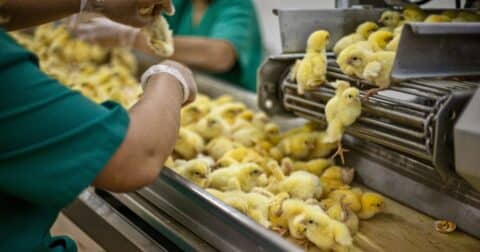News
Our Favorites Stories of 2025
Food•5 min read
Solutions
The brand worked closely with animal welfare scientists to implement in-ovo sexing.


Words by Lauren David
Kipster, which claims to be “the first carbon-neutral” egg hatchery in the world, will also be the first to sell eggs in the U.S. using a new kind of technology, one that aims to improve animal welfare for chickens. In-ovo sexing technology enables egg producers to identify the sex of the chicken embryo before hatching. Debuting this fall from Kipster, it’s one of many technological advancements developed to eliminate culling, the practice of killing day-old male chicks.
Kipster had initially pledged to eliminate culling in 2022 by raising the roosters to sell as meat. “We didn’t succeed because the infrastructure in the U.S. is not there,” says Ruud Zanders, a co-founder of Kipster. In the Netherlands, Zanders is one of the few that raises male chicks for rooster meat and sells it, along with eggs. But in the U.S., he says, in-ovo sexing is the next best option. Another company, Egg Innovations, was the first to commit to in-ovo sexing, but won’t implement it until 2025. Once fully adopted, the technology will save up to 300 million male chicks per year in the U.S. alone.
Kipster has an established track record on animal welfare. Their barns and outdoor spaces are designed to accommodate foraging and dust bathing, for instance. The group also works closely with animal welfare groups, including The Humane League and Compassion in World Farming.
Poultry farms use both male and female birds, but egg hatcheries see males as useless, since they don’t lay eggs and they don’t produce much meat. Up until the 1920’s, farmers in the United States raised the same chicken breeds for meat and for egg-laying. But the industry changed when selective breeding was introduced, along with the chicken broiler variety.
Most hatcheries employee chicken sexers to determine if a chick is male or female. Females become laying egg hens but males are culled. One of the most common methods for culling used in the United States and Canada is maceration, where day-old chicks are thrown into a big grinder and ground up or shredded alive.
Culling is also done by gassing, suffocation, electrocution or drowning. In total, up to 300 million male chicks that are a few hours old are killed in the United States every year and globally around seven billion chicks, explains Giovana Vieira, an animal welfare scientist at The Humane League.
In-ovo sexing technology aims to prevent those deaths by determining if the chicken embryo is male or female before the egg hatches. Male eggs taken out of incubation can be used for animal feed. This minimizes waste, reduces the impact on the environment and stops the horrific practice of killing millions of baby chicks while they’re still alive.
Animal welfare groups have long been calling for an end to chick culling, yet the U.S. has lagged behind in passing laws to prohibit this practice. Several countries in Europe have passed legislation banning culling, including Germany, France and Austria. Italy is slated to end the culling by the end of 2026.
In the U.S., The Humane League has been working with the United Egg Producers, a farmer cooperative, to persuade the group to agree to stop chick culling in all commercial egg production, Vieira tells Sentient. The United Egg Producers represents around 90 percent of all eggs laid in the U.S. so the decision will have a huge impact.
For now however, despite the agreed upon ban, culling is still legal and common here. The United Egg Producers “has been dragging its feet on enforcing the ban,” Julia Wisner, a director of public relations at The Humane League told Sentient, “despite technologies being available across Europe and while chicks continue to be shredded alive just hours after birth.”
A number of biotech companies are working to market technologies that detect the sex before an egg hatches. Some in-ovo sexing techniques are more invasive — a machine pierces the egg, extracts and tests fluid to determine the sex, for instance. A technician then seals the tiny hole with edible beeswax or other natural sealant. But there are less invasive methods, including image scanning and scent detection.
Sensit Ventures, Inc, a startup biotech company working with researchers at UC Davis, California are using the scent of a fertilized egg to figure out if an embryo is male or female. A suction cup is placed over the egg where volatile chemicals are detected in the egg shell to distinguish the sex. “We don’t actually have to identify specific chemicals,” says Tom Turpen, president and CEO of Sensit Ventures, in determining the embryo sex. “All we need to do is show that there’s a pattern that matches male and a pattern that matches female.”
The company also uses machine learning to find patterns to figure out which are male and female embryos, and DNA testing to confirm their findings. “We sample the eggs, collect the dispersion plots, then, we take the eggs over to the Veterinary Diagnostic Center on campus, and they extract a little bit of DNA and tell whether it’s male or female from the chromosome,” Turpen explains. Currently, the accuracy of knowing if the egg is male or female is around 80 percent, according to the company. Turpen expects they need another year of research before their in-ovo technology is ready.
Scaling in-ovo sexing technology for the U.S. has been a challenge. And without laws banning culling, there is less pressure on egg farms in the U.S. to take the initiative to find alternative solutions. Though Vieira calls the added costs “minimal,” the egg industry has pointed to it as a barrier to making the change.
Zanders explains his hatchery has 100,000 laying hens, who produce around 25-26 million eggs a year. They’re relatively small, he says, considering there are around 350 million laying hens in the U.S. in total. Still, Kipster currently sells their eggs in 28 states in Kroger grocery stores. And this spring, shoppers will be able to purchase eggs that are cull-free.
Update: This piece has been corrected as an earlier version incorrectly attributed a quote to Giovana Vieira rather than Julia Wisner. The first sentence has also been changed to note that Kipster’s carbon neutral status is the company’s claim. The last sentence has been corrected to reflect that cull-free eggs will hit grocery stores around April.